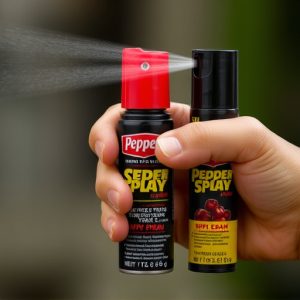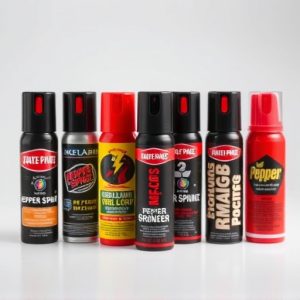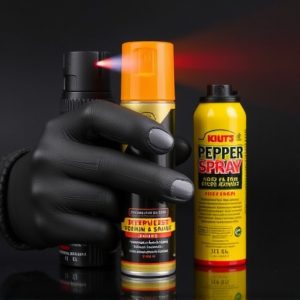Decoding Factors Behind Pepper Spray Manufacturing Costs and Market Trends
The cost of manufacturing pepper spray is multifaceted, influenced by raw material expenses, partic…….
The cost of manufacturing pepper spray is multifaceted, influenced by raw material expenses, particularly for oleoresin capsicin, which can fluctuate due to market dynamics and climate effects on agricultural production. Production costs are further increased by the need for advanced technology and machinery, safety and environmental compliance, and investment in research and development for product innovation. Manufacturers must navigate these costs while also implementing effective marketing strategies and establishing strong distribution networks to maintain competitive pricing and market presence. The pepper spray industry is highly competitive, with manufacturers striving to differentiate their products through quality, brand reputation, and continuous innovation. This dynamic environment requires manufacturers to balance cost-effectiveness with profitability, considering economies of scale, market saturation, new competitor entries, and existing regulatory hurdles that affect both production costs and final retail prices. The regulatory landscape for pepper spray is strict, ensuring high safety and efficacy standards, which necessitates additional investment but also ensures product quality and consumer protection. Future cost trends will likely be shaped by technological advancements, formulation improvements, and evolving regulations, all of which will influence the pricing of pepper spray products in a market that is continuously adapting to new challenges and opportunities.
When considering the cost of pepper spray, a myriad of factors comes into play, each influencing the final price tag. This article dissects these elements, from the raw material fluctuations to regulatory compliance that manufacturers must adhere to. We delve into how competition among pepper spray manufacturers shapes market dynamics, affecting both consumer prices and industry profitability. Additionally, we explore the future cost implications, forecasting trends that could affect personal defense tool expenses. Understanding these facets provides a comprehensive view of pepper spray pricing mechanisms.
Understanding the Factors Influencing Pepper Spray Manufacturing Costs
Understanding the factors influencing the manufacturing costs of pepper spray requires a comprehensive look at several key elements within the industry, particularly as they pertain to pepper spray manufacturers. The cost structure for these manufacturers is multifaceted and includes raw material acquisition, production processes, regulatory compliance, research and development, and marketing strategies.
Raw materials, such as oleoresin capsicum—the active ingredient in pepper spray—are a significant component of the overall cost. The price of this ingredient can fluctuate based on market demand, crop yield, and supplier competition. Additionally, the equipment and technology used during production play a crucial role in determining costs. Advanced machinery for precise dosage and packaging can increase initial investment but may lead to more efficient production, potentially offsetting these costs over time.
Compliance with stringent safety and environmental regulations also adds to the manufacturing expenses. Pepper spray manufacturers must adhere to regulations that govern chemical handling, product labeling, and disposal practices. Moreover, ongoing research to enhance formulation effectiveness and safety, as well as to develop new products, requires substantial investment. Lastly, effective marketing and distribution channels are essential for reaching consumers and achieving market penetration, which also contributes to the overall cost structure of pepper spray manufacturing. Understanding these factors helps stakeholders appreciate the complexities behind the pricing of pepper spray and the importance of responsible and strategic production by manufacturers in the industry.
Market Dynamics: How Competition Among Pepper Spray Manufacturers Affects Prices
The competitive landscape within the pepper spray market significantly influences the pricing dynamics of this niche. Manufacturers of pepper spray must navigate a complex environment where factors such as production costs, market demand, and regulatory compliance play pivotal roles. As competition intensifies, manufacturers strive to differentiate their products through innovation, quality, and brand reputation, which can affect the cost structure and subsequently the retail prices consumers face. Economies of scale often lead to price reductions when manufacturers increase output, but this is counterbalanced by the need for continuous investment in research and development to improve formula effectiveness, safety, and user-friendliness. The balance between maintaining a competitive edge and ensuring profitability shapes how pepper spray manufacturers set their prices. Additionally, market saturation and the entry of new players can drive down prices through increased competition, while exit barriers, such as regulatory hurdles and high fixed costs, prevent rapid fluctuations in supply that could otherwise lead to significant price changes. These market dynamics necessitate a strategic approach by manufacturers to pricing, with an eye on both maintaining market share and staying ahead of competitors.
The Impact of Raw Material Variations on Pepper Spray Pricing
The cost of raw materials plays a pivotal role in determining the price of pepper spray, influencing the economics for pepper spray manufacturers significantly. Fluctuations in the prices of capsaicin, the active ingredient responsible for the pungency of pepper sprays, and other chemicals used can lead to substantial variations in production costs. Capsaicin extraction from chili peppers is a complex process that requires specific conditions and expertise; therefore, its availability and purity levels affect the overall cost structure. Additionally, manufacturers must consider the expenses associated with compliance and safety regulations, which are imperative for producing pepper spray responsibly. These costs, coupled with the fluctuating prices of raw materials, necessitate a dynamic pricing model in the industry. As a result, consumers may observe changes in the retail price of pepper sprays as suppliers adjust their prices to reflect these market dynamics. Pepper spray manufacturers must navigate this volatility while maintaining product quality and safety, a delicate balance that requires both strategic planning and agility in supply chain management.
Regulatory Compliance and Its Role in Pepper Spray Production and Pricing
The production and pricing of pepper spray are subject to stringent regulatory compliance measures that directly impact both manufacturers and consumers. These regulations dictate the standards for raw materials, manufacturing processes, and safety protocols that pepper spray manufacturers must adhere to. Compliance with such standards ensures that the pepper spray products meet the necessary criteria for efficacy and safety, which is paramount given the potency of these self-defense tools. The regulatory framework not only safeguards users but also sets a minimum quality benchmark across the industry. This uniformity in quality can influence production costs as manufacturers invest in compliant processes and materials, which are often more expensive than non-compliant alternatives. Consequently, the price of pepper spray products to consumers reflects these costs, with compliance-driven manufacturing leading to a higher retail cost compared to substandard or non-compliant counterparts.
In addition to influencing production costs, regulatory compliance also affects the pricing and distribution of pepper spray. Manufacturers that maintain compliance are often certified and authorized to sell their products in various markets, including those with strict regulations regarding self-defense items. This certification can be a significant factor in determining market accessibility and can lead to higher retail prices due to the broader trust and credibility granted to compliant products. Furthermore, compliance-related paperwork, certifications, and ongoing inspections add to the operational costs for manufacturers, further justifying the pricing of pepper spray products in the consumer market.
Trends and Predictions: Future Cost Implications for Pepper Spray Products
The pricing trends and future cost implications for pepper spray products are influenced by several factors, including raw material costs, production methodologies, and market demand dynamics. Manufacturers of pepper spray have had to navigate fluctuating prices in raw materials such as oleoresin capsicum, which is the active ingredient in pepper sprays. As global agriculture faces both yield uncertainties due to climate change and shifts in demand from other industries, the availability and cost of this critical component can vary significantly. This volatility in supply chain costs often translates directly into consumer pricing, with manufacturers adjusting their prices to maintain profitability.
Looking ahead, the cost of pepper spray products is expected to be shaped by advancements in technology and formulation enhancements. Manufacturers are continuously innovating to improve the effectiveness and safety of these self-defense tools. Additionally, regulatory changes can impact costs; for instance, stricter regulations may necessitate new equipment or safety measures, which could increase production expenses. The competitive landscape also plays a role in shaping prices, as manufacturers strive to offer products that balance efficacy with affordability to capture market share. As such, consumers can anticipate a continued evolution in the cost of pepper spray, reflecting broader economic trends and ongoing technological advancements within the industry.


